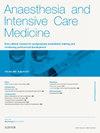止痛药中的非阿片类药物
IF 0.3
Q4 ANESTHESIOLOGY
引用次数: 0
摘要
国际疼痛研究协会(International Association for The Study of Pain)将疼痛定义为“一种不愉快的感觉和情绪体验,与实际或潜在的组织损伤有关,或与这种损伤有关。”镇痛药可以根据其主要作用于伤害感受和疼痛感知大致分类,两者都与疼痛体验密切相关。对疼痛通路的理解是对治疗靶点如何作为镇痛药的良好理解所固有的。本文概述了治疗干预的基本原理。阿片样物质是作用于阿片受体产生类似吗啡作用的物质。所有其他不通过阿片受体产生镇痛作用的镇痛药可被标记为非阿片镇痛药(NOAs)。阿片类药物增加了成瘾和过量的风险,支持长期使用阿片类药物治疗慢性疼痛的证据有限。本文旨在概述疼痛通路与提供镇痛治疗靶点的关系,常用的nao及其简要介绍。本文章由计算机程序翻译,如有差异,请以英文原文为准。
Non-opioid medication in pain medicine
The International Association for the Study of Pain defines pain as “an unpleasant sensory and emotional experience associated with actual or potential tissue damage or described in such terms of such damage.” Analgesics can be broadly classified according to their role primarily on nociception as well as pain perception, both of which are intimately integrated to the pain experience. An understanding of the pain pathway is inherent to a good understanding of how therapeutic targets can act as analgesics. An overview is discussed in this article to understand the rationale for therapeutic intervention. Opioids are substances that act on opioid receptors to produce morphine-like effects. All other analgesics that do not produce analgesia through a primary effect on opioid receptors can be labelled as non-opioid analgesics (NOAs). Opioids increase the risk of addiction and overdose and there is limited evidence supporting their long-term use for chronic pain management. This article will aim to provide an overview of the pain pathway in relation to the therapeutic targets for providing analgesia, commonly used NAOs and their brief introduction.
求助全文
通过发布文献求助,成功后即可免费获取论文全文。
去求助
来源期刊

Anaesthesia and Intensive Care Medicine
ANESTHESIOLOGY-
CiteScore
0.50
自引率
0.00%
发文量
152
期刊介绍:
Anaesthesia and Intensive Care Medicine, an invaluable source of up-to-date information, with the curriculum of both the Primary and Final FRCA examinations covered over a three-year cycle. Published monthly this ever-updating text book will be an invaluable source for both trainee and experienced anaesthetists. The enthusiastic editorial board, under the guidance of two eminent and experienced series editors, ensures Anaesthesia and Intensive Care Medicine covers all the key topics in a comprehensive and authoritative manner. Articles now include learning objectives and eash issue features MCQs, facilitating self-directed learning and enabling readers at all levels to test their knowledge. Each issue is divided between basic scientific and clinical sections. The basic science articles include anatomy, physiology, pharmacology, physics and clinical measurement, while the clinical sections cover anaesthetic agents and techniques, assessment and perioperative management. Further sections cover audit, trials, statistics, ethical and legal medicine, and the management of acute and chronic pain.
 求助内容:
求助内容: 应助结果提醒方式:
应助结果提醒方式:


